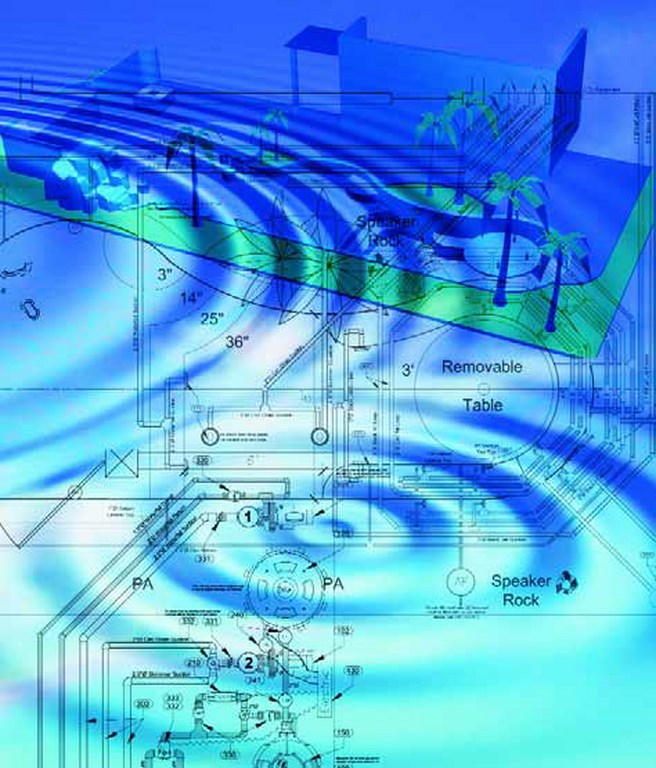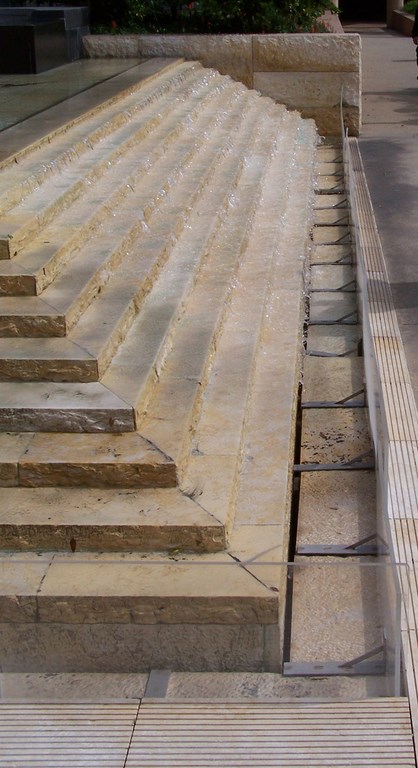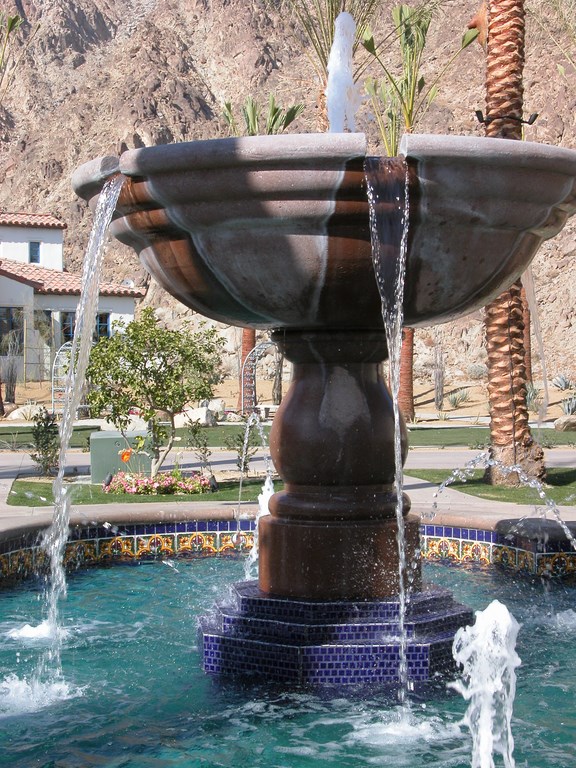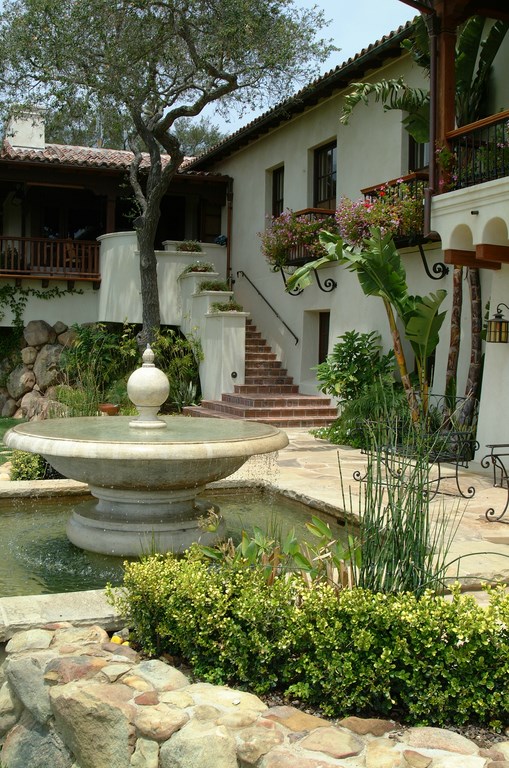Fluid Dynamics

Who took the water out of watershapes?
That may seem a ridiculous question, but it’s also an obvious one when you see as many plans as I do – and by that I mean plans intended to indicate and initiate the watershaping parts of a wide variety of projects. Indeed, in my long experience in running an engineering-oriented firm, I’ve repeatedly been asked by designers to flesh out their watershape “ideas” (although in most cases vague inklings would probably be a more accurate way to describe them) and provide working drawings that reflect their “thinking.”
In my estimation, more than three-quarters of these plans lack any real indication of what the designers expect the water to do or how they want it to look. Instead, what I get is the typical overhead views with the ubiquitous “blue ghosts” or, in some cases, rudimentary sections of structures designed to contain water. It’s left to me to probe and ask questions and determine what expectations they have about how the water is to appear and what it is to do.
I’ve endured these common plan shortcomings for more years than I care to count, always wondering why is it that landscape architects in particular do not seem to be able to tell the engineering and contracting trades what they want with respect to water’s movement and its other visual characteristics. It makes no sense to me that such key elements of visual programs should be left to chance by otherwise worthy, well-trained professionals.
These are the same landscape architects who have no problem at all in specifying every single pipe fitting in an irrigation system: For some reason, they just can’t be bothered to provide information about the most basic component of a watershape – that is, the water itself. And it is increasingly my observation that the problem starts in school – at the very beginning of these designers’ careers.
ROOT CAUSES
Indeed, when I set out to design a curriculum on water for landscape architecture students, I made it one of my primary goals to address this gap in information and communication. Quite simply, I think it’s something that any worthwhile course on watershaping should address in detail.
That’s why, back in the first installment of this “Future Class” series in March 2007 (click here), I listed a set of “commandments” landscape architects should follow in preparing plans for watershapes. One of those directives has to do with the dynamics of water and what designers needed to include in plans so nobody would be surprised by the results – neither the client nor the designer.
Following through on that program, I’ve urged my students to embrace the idea that the key to effective watershape design has largely to do with how well a plan communicates the way water moves within a system at what flow rates, in what volumes and with which aesthetic ambitions.
| There are certain effects that absolutely require a designer to be familiar with water’s dynamic behavior. In the cacophonous fountain complex seen here (left), for example, designer Lawrence Halprin had to know what volumes and flow rates would be involved to create the visual impression he was after before beginning to arrange his monoliths. Similarly, the designer of this classic water chain (right) had to be familiar with the behavior of water flowing downwards across textured surfaces to keep the water under control. |
If a set of plans lacks quality specifications for these water dynamics, then the person or firm charged with executing the design will never know for sure how best to proceed and, short of taking the initiative to find out for certain they way I do, will be forced to guess. And the guesswork is far from superficial, as it includes not only final appearances but also the equipment, the plumbing and even the sizes and shapes of the vessels themselves.
Experience tells me that, lacking specificity, many engineers and most contractors will get things wrong – at least so far as the designer’s “vision” is concerned – and that problems invariably flow from incorrect assumptions. This disconnect can lead to substantial change orders as the designer intervenes to restore the project’s direction – which in turn leads almost as invariably to unhappy clients and, occasionally, to abandonment of the project.
Because landscape architects are college educated, many assume that they are authorities when it comes to watershape design. To test this notion, I concluded this year’s construction-class session – intended for third-year students in the program who should have known a thing or three by then – with a gut-check on what they’d learned so far in their “construction education.”
It was simple: I asked each of about 60 of them to draw a construction detail and give me design details I’d need to engineer and build a watershape. I wanted to see how many of them would give me some indication of what they wanted the water to do, and about a quarter of them did just that. The remaining three quarters, however, offered me objects that might hold water – occasionally with some minor line work to symbolize water – but nothing more.
A CLASS APART
I don’t suppose I should have been surprised that the ratio here among students was the same as the one I’d observed among practicing professionals, but to say I was disappointed would be an understatement.
There’s a bitter irony here, because in the conventional view, watershape design begins with the water: The walls, weirs, floors, nozzles, edges, rock structures, cisterns and even the plumbing and the vessel are all designed in support of the desired visual effects and the dynamics of the water itself. By considering the structures first, most of these budding designers were, in fact, working exactly backwards.
| Few of those who haven’t undertaken a large fountain project have any clear understanding of just how much water must flow to keep certain effects going. In the case of the oval fountain at Villa d’Este, for example, the back side of the bowl must be fed with a precisely controlled flow from the cascades above to create the exact ribbons of water we see at the bowl’s rippled rim (left). Then there’s the villa’s water organ – about as complete a tour de force of water effects as I’ve ever seen, with jets of all visual weights, sizes and heights (right) as well as various flows over weirs and across pools. (All that and music, too.) In these cases, water is the design, and setting these features up with any level of success required consummate knowledge of water’s dynamics. |
Therein rests the core of the problem and an explanation for why so many landscape architects are disappointed when their designs have actually been built. Only now, once construction is well on its way to completion, do they start commenting on the appearance and water-dynamics issues – and it’s far too late because pipes were glued and concrete applied long ago. Obviously, this hindsight leaves poor design, unwanted execution and displeased clients in its wake – outcomes that hurt all of us professionally.
Of course, I’d been through this same curriculum years before as a student at the university at which I now teach, but I’d pursued the program while working simultaneously for a pool contractor and had been charged through that period with preparing pool and spa designs for construction.
| The consequences of a designer’s lack of familiarity with water’s behaviors can be aesthetically grim – as in this case, where plastic “sneeze guards” of the sort you’d see at a salad bar had to be set up to keep splash-out from creating a slip hazard on the deck adjacent to this stepped fountain. |
Even then, I was aggressive enough to question my college instructors to find out how much they actually knew about water. To my dismay, while some of them had the language down (or some of it, anyway), there was only one among all of them who had any real familiarity with watershape construction – and he was a contractor as well as a licensed design professional.
My life’s experience, coupled with the small exercise to which I’d subjected my students, leads me to believe beyond question that there’s a need to improve the quality of education if we are ever to change anything about the way landscape architects approach watershaping. To my way of thinking, that improvement will only begin when, in our classrooms, we place a priority on communicating how water is to behave in given systems.
We’ve been encouraging students to look at things backward for years beyond count. Now’s the time to begin swinging things around and persuading current students and future designers (not to mention others who read this magazine) to approach these issues from the right direction.
CLEAR SOLUTIONS
As big a problem as this may be, the solution begins with a simple question: How is any contractor to be expected to build what you want if you don’t tell them what it is? In other words, how can you expect excellence if you don’t define an expectation for the appearance and performance of the water in your watershapes?
Providing clarity in these situations involves defining the water’s dynamics. As discussed in the last article in this series (“Coming to Terms,” click here), the language used in watershaping can be imprecise, and I have little doubt at this point that the term dynamics is subject to interpretation. Let me take a stand, however, and say that the term describes how water acts both visually and audibly – how it behaves when presented to people who are given the opportunity to enjoy it.
| The technical issues involved in successful watershape designs may seem simple at first, but making some of them actually happen can prove to be sublimely challenging. In the case of this small courtyard fountain, for example, it took an elaborate set of hydraulic calculations and installation of precise on-site control systems to get the flow up through the urn to do no more than wet the entire surface of the urn itself – a trick complicated dramatically when considerations of surface tension enter the mix. Then that flow had to be factored into the volume and flow needed to wet the entire perimeter of the basin and push the water toward the slot below. |
Yet whatever the terms we use or how we define them, the simple fact is that the need to convey basic information about what we want and how we want it to appear remains the same. Any designer needs to tell both clients and contractors whether a waterfall will be a trickle or a torrent, whether it will pass over a defined weir or move through crevices as thin, flowing fingers. Her or she needs to be able to explain that a nozzle will shoot a foot into the air or fly 30 times that high – and whether it is to be a laminar stream or a foaming surge. He or she must be able to define whether a flat water surface should be dark and highly reflective or transparent to reveal features beneath the waterline.
For simplicity’s sake, let’s break key characteristics out in ways that define visual distinctions and performance issues as clearly as possible.
[ ] Waterfalls and Weirs: All landscape architects need to approach any weir they see in everyday life and stick a finger on the edge, pull it away and then measure approximately how deep the water is as it runs over an edge. In time, this will provide each designer with his or her own set of references having to do with what he or she wants to see and will speed communications with engineers and contractors.
We all need to know what the difference is between an eighth of an inch of water flowing over an edge and an inch. There is a drastic visual difference between the two, and knowing what’s up in these cases empowers the designer to think and communicate not only about water volumes, but also about the pumping power needed to carry off each effect.
This all can, of course, get very complicated. The consistency of an edge, for example, is crucial in determining how much water it takes to get a clean sheet of water to fall over an edge with no dry spots, and the edge’s configuration has a role to play in determining the texture of the falling water sheets. Basically, you need more water. And there’s also the texture of the material over which the water passes: You need a greater flow of water to create a sheet flow over a piece of flagstone than you do over honed granite to maintain the same appearance in the water effect.
Now apply what you’ve observed: When you see a watershape in which an edge is either over-supplied or starved for water, you know for certain that the effect was designed and built with less concern about the expectations of the designer and more concern about just finishing the job. Getting these effects right takes both precise hydraulic calculation as well as experience, and everyone is better off if a landscape architect defines expectations ahead of time instead of complaining after the work is completed.
[ ] Bowls and Basins: As with weirs, a bowl’s visual performance when the water flows depends upon how deep the water is as it flows over the rim. That seems simple enough, but the fact is that inexpensive bowls are imprecisely made, which means it’s often necessary to use more water to achieve uniform flow all the way around the bowl.
| Even in what seem to be ordinary bowl fountains, getting things right is seldom as simple as it seems. Controlling the flow from bowl to bowl can be quite difficult (left), and the equipment needed to drive these substantial water volumes can get very large in a hurry. Of course, there are alternatives: In another fountain (right), for example, the notches in the bowl allowed for the use of a smaller volume of water, dramatically simplifying the hydraulics and, in time, aiding the composition’s visual cause by creating interesting patterns on the bowl itself. |
While most landscape architects take great care in picking out bowls from various catalogs for their aesthetics, they are frequently surprised to learn that huge water flows are needed to achieve the envisioned performance – even with a well-crafted, precision-honed rim. And if that bowl has an inconsistent edge, achieving even flow may require anywhere from seven to ten gallons per minute per foot of bowl rim. If the bowl is ten feet in diameter (which means an edge that is 31.4159 feet long), the required flow rate could be as much as 310 gallons per minute!
The significance of that flow is magnified down below: If the basin under the bowl has a capacity of only a few hundred gallons, then there will need to be a separate filtration system along with a feature pump because of most filters’ low flow rates. This set of potentialities takes a simple-seeming fountain and makes the project one that requires an equipment set bigger than those found on most residential pools.
Performance concerns such as these are why fountains in commercial settings end up costing up to six figures when everyone seems to be expecting something in the very low five figures. Avoiding such hassles is simply a matter of thinking things through – and providing landscape architects with the information they need to design fountains and other watershapes that are economically efficient as well as beautiful.
[ ] Nozzles and Jets: When effects defy gravity and water shoots upward, landscape architects have significant choices to make about how the water looks and acts during its voyage. Nozzles will send water straight up, arc it across distances great or short, or send it sideways and even downward.
Nozzles can also aerate water into bubbling masses or create tight, laminar streams that resemble nothing so much as arching acrylic rods. They can send water hundreds of feet into the air or up just a few inches. In combinations, arrays of nozzles can create elaborate sculptural patterns in the centers of large bodies of water – or small, simple patterns in the most compact of watershapes.
Without offering information about the physical orientation of these nozzles and jets; specifics about their locations in a design; the desired effects; and the distances they are supposed to cover through the air, the designer leaves a contractor to guess at all of these characteristics.
None of this, of course, should be left to chance: The designer needs to determine nozzle selection, flow rates, system pressure and pump selection, not to mention the need to define the dimensions of the vessel that will capture the moving water. And the issues aren’t all aesthetic: These details can be critical in defining and controlling splash out, in establishing safety for interactive play features, in offering the ability to light the moving water – and much, much more.
[ ] Water Surfaces: A flat surface of water can take on many different appearances depending on how the movement of water and the shape and color of the structures that contain it are defined. If that surface is meant to reflect surrounding views and structures, for example, it needs to be as still as possible – a detail significantly complicated if the design includes arcing border jets that disturb the surface and disrupt reflections. The same is true for water that is meant to reveal subsurface structures or the imagery of tile mosaics.
Even the color of surfacing materials (not to mention the choice of that material itself) can play a major role in the water’s appearance: Dark colors tend to be more reflective than light ones, but there are also significant distinctions between the way an iridescent glass tile influences surface appearance compared to a material that has no reflective qualities.
FAR AND WIDE
Everything under discussion here is about the designer knowing what he or she wants, thinking through the implications of added details and communicating basic needs and desires to engineers and contractors so all project elements can come together in ways that please clients and meet their expectations.
To me, this understanding of the characteristics of water and the ability to communicate effectively about desired effects are basic design necessities, points of professionalism that every designer should embrace in every generated plan: They cut to the heart of watershaping as both an art form and a technical challenge.
If I am blunt in addressing these issues, recall that my immediate audience is 20-year-old students for whom I’m trying to unstuck the deck when it comes to watershaping. My intention is to make them better prepared to generate plans that inform engineers and contractors and serve to turn their ideas into actual watershapes.
For those of us who are already working professionally, the deck is no less stacked, making it critical for us to expand our bases of knowledge and strive to be informed, clear and precise when it comes to envisioning, specifying and realizing the nature of desired water effects.
It makes sense – and needs to be much, much more common.
Mark Holden is a landscape architect, pool contractor and teacher who owns and operates Holdenwater, a design/build/consulting firm based in Fullerton, Calif., and is founder of Artistic Resources & Training, a school for watershape designers and builders. He may be reached via e-mail at [email protected].



















